Written by: Sima Cong AI Channel
This report does not involve valuation analysis, and less involves token analysis. This report is based on the sorting out of investment logic rather than the typical token price trend analysis in token economics.
What are you imagining?
Don’t be indifferent, and don’t be complacent. Embrace the trend. We can imagine the following:
l New landscape of crypto asset market;
l Business integration of traditional finance and encryption;
l Innovative business;
l The benefits brought by regulatory recognition;
l The expansion of usage scenarios will lead to a wider range of business models and profit models. For example, an app can immediately convert any stablecoin into the stablecoin of other institutions and deposit it into the account. This is almost unimaginable in the traditional financial world (provided that the KYC and AML of app users are completed).
The driving force behind progress for governments, regions and businesses around the world: to stay one step ahead.
As for mainland China, it can go global through the window of Hong Kong’s stablecoin that supports offshore RMB.
However, it is important to note that if you cannot understand regulation, you cannot truly understand innovation and imagine the future. Only when we understand the value of regulation can we truly understand the value of innovation. Regulation not only solves current problems, but also creates stability for the future norm. This stability and predictability is one of the indispensable reference standards for investment.
The underlying logic in history: Regulatory recognition and legitimacy are necessary conditions for the growth of the industry
Regulation itself is not a stumbling block to innovation, but a necessary condition for the development of the industry.
There are countless examples like this. History tells us that regulation is not a stumbling block to innovation, but a necessary condition for promoting the industry from being remote to being mainstream. Ultimately, the industry achieves prosperity and continuous innovation under the impetus of regulation.
Internet Finance (FinTech) - Taking the UK Fintech Regulatory Sandbox as an example
After the 2008 financial crisis, the traditional banking system was questioned, and new financial services such as P2P lending, digital payments, cryptocurrency, and blockchain emerged rapidly. There was a regulatory vacuum, and a large number of start-ups grew wildly. Risk events occurred frequently (such as the Lending Club scandal and the bankruptcy of Mt. Gox exchange). The UK Financial Conduct Authority (FCA) launched the "Regulatory Sandbox" to allow start-ups to test new products or services in a controlled environment. The UK has become one of the global Fintech centers; London has become the largest Fintech investment destination in Europe; a number of world-class financial technology companies such as Revolut, Monzo, and TransferWise (now Wise) have emerged; countries have followed suit, forming a global trend of "sandbox regulation."
To this day, Hong Kong regulators still use a regulatory sandbox approach to the entry of stablecoins into the market.
In 2022, the collapse of USDT triggered a stablecoin credit crisis. This made many people doubt whether USDT had enough US dollar assets in reserve. In fact, USDT has defects. This automatic trading mechanism does not really understand the logic of finance, especially the liquidity crisis. In 2023, the Silicon Valley Bank crisis caused a sharp drop in USDC, which had a large amount of assets in Silicon Valley Bank. These two events made more people realize that stablecoins are not safe and need to be regulated.
This is a concrete scene of the latest development
Walmart and Amazon are exploring issuing their own stablecoins.
Ø Stablecoins have the potential to save merchants billions of dollars in fees and provide faster payment processing.
Ø Whether to move forward depends on the regulatory framework for stablecoins in the Genius Act currently being discussed by the U.S. Congress.
Ø Imagine that the stablecoins issued by merchants themselves are as popular as "coupons". In addition to reducing costs and completing payments quickly, they can also become a tool for promoting the merchants' main business.
Moving the vast majority of cash and card transactions they process outside the traditional financial system and saving them billions of dollars in fees.
Walmart, Amazon.com and other multinational giants have recently explored whether to issue their own stablecoins in the United States.
Expedia Group and other large companies, such as airlines, have also discussed plans to issue stablecoins.
Currently, stablecoins are used to store cash or purchase other cryptocurrency tokens. They should be pegged one-to-one with the U.S. dollar or other fiat currencies and backed by cash or cash-like assets (such as U.S. Treasuries) as reserves.
What these retailers ultimately decide will depend on a bill called the Genius Act, which would begin to establish a regulatory framework for stablecoins. The bill recently passed another procedural hurdle but still needs to pass the Senate and House of Representatives.
Stablecoins allow merchants to bypass traditional payment rails, which cost them billions of dollars each year in fees, including those paid by customers when they make purchases with credit cards.
Traditional payment settlements can take days, slowing down the time it takes for merchants to receive payment for their sales. Stablecoins promise a faster settlement process, which is particularly attractive for merchants with overseas suppliers.
For years, merchants have been trying to offer alternative payment methods to break away from the card swipe system dominated by Visa and Mastercard, but most efforts have failed to make significant progress.
According to The Wall Street Journal, large banks have also been considering forming their own stablecoin alliance.
Merchant industry groups have been meeting with lawmakers in recent years to push for the passage of the Genius Act. These groups, led by the Merchant Payments Alliance, say a regulatory framework for stablecoins would provide merchants with an alternative payment method that would significantly reduce costs and compete with Visa and Mastercard.
From this, we can clearly see a real narrative: a bill called the "Genius Act", that is, the recognition and legitimacy of centralized supervision.
What kind of signal is this?
A clear signal: digital finance will bid farewell to wild growth and enter a mature development stage with "compliance" as its cornerstone.
This is the logic behind
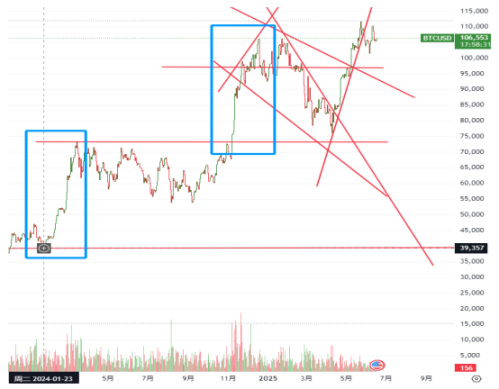
As we can see, Bitcoin’s two major price movements that broke new all-time highs were driven by the recognition and legitimacy given by centralized regulation: the passage of a spot Bitcoin ETF and the election of President Trump with his continued promises of cryptocurrency-friendly regulatory policies.
It is the passage of spot ETFs that provides a legal basis for a steady stream of capital liquidity. It is also Trump’s election that has led to everything we see now, including the Genius Act. The essence of centralized supervision is that it has gone from disapproval or even suppression in the past to recognition and the key stage of granting legitimacy.
The only problem:
In the face of this unstoppable trend, where and what are the opportunities?
The trend is visible to the naked eye
Ant International: Submit application for Hong Kong stablecoin license as soon as possible
Hong Kong's "Stablecoin Ordinance" will come into effect on August 1, and the Singapore Bank has released a stablecoin regulatory framework in August 2023.
On June 12, 2025, Ant International responded that it is accelerating investment and expanding cooperation in global treasury management, and is putting its AI, blockchain and stablecoin innovations into real, reliable large-scale applications.
Ant International said, "We welcome the passage of the Stablecoin Bill by the Hong Kong Legislative Council, which will take effect on August 1. After the relevant channels are opened, we will submit our application as soon as possible and hope to contribute more to Hong Kong's construction of an international financial center."
Ant Digits has started applying for a Hong Kong stablecoin license and has had multiple rounds of communication with regulators. It is reported that Ant Digits has listed Hong Kong as its global headquarters this year and has completed a pilot test of the regulatory sandbox in Hong Kong.
As a bridge between traditional finance and tokenized assets, stablecoins have broad market potential. Their core value lies in the expansion of usage scenarios and compliance construction.
The "Stablecoin Ordinance (Draft)" of Hong Kong, China was passed by the Legislative Council of Hong Kong on May 21, 2025, signed by the Chief Executive, published in the Gazette on May 30, and officially implemented on August 1, 2025. It is expected that the transition period arrangements will be completed within 2025 and the first batch of licenses will be issued.
On August 15, 2023, the Monetary Authority of Singapore (MAS) announced the final regulatory framework for stablecoins, becoming one of the first jurisdictions in the world to incorporate stablecoins into the local regulatory system. MAS allows the issuance of stablecoins anchored to a single currency, which can be the Singapore dollar (SGD), as well as G10 currencies. G10 currencies include the Australian dollar, Canadian dollar, British pound, euro, Japanese yen, New Zealand dollar, Norwegian kroner, Swedish kronor, Swiss franc and US dollar. MAS does not allow the issuance of stablecoins pegged to a basket of currencies, nor does it allow stablecoins pegged to digital assets and issued by algorithms.
On June 10, 2025, South Korean President Lee Jae-myung, who had just been elected for less than a week, quickly fulfilled his campaign promise to allow local companies to issue stablecoins. According to media reports, Lee Jae-myung's Democratic Party proposed the "Basic Digital Asset Act", which stipulates that South Korean companies with a capital of more than 500 million won (about 368,000 US dollars) can issue stablecoins.
The wealth effect is real
The world's second largest stablecoin Circle was listed on the New York Stock Exchange, with a first-day increase of 168.48%.
On June 5, local time, Circle, the world's second largest stablecoin USDC issuer, was officially listed on the New York Stock Exchange with the stock code CRCL and an issue price of $31 per share. Circle triggered circuit breakers several times after opening, with a 168.48% increase on the first day of listing, closing at $83.23, and a total market value of $18.4 billion. The trading volume on that day reached 47.109 million shares, equivalent to approximately $3.941 billion.
As of March 31, 2025, the USDC held by Circle is worth $59.976 billion. Circle's business model is very clear. The company issues USDC, a stablecoin pegged 1:1 to the US dollar, and invests the $59.976 billion deposited by users in short-term US Treasury bonds and cash to earn risk-free returns. It earned about $1.6 billion in reserve income, or interest income, in 2024, accounting for 99% of Circle's total revenue.
In 2024, the total transaction volume of stablecoins will reach 27.6 trillion US dollars, surpassing Visa and Mastercard's annual transaction volume of about 25.5 trillion US dollars for the first time. At present, the total market value of stablecoins in the world has reached 248 billion US dollars, of which USDC issued by Circle accounts for about 25% of the market share, with a total market value of 60 billion US dollars, second only to USDT issued by Tether, which has a market share of about 61%. In addition to USDC, Circle also issues and manages the euro stablecoin EURC, with a market value of about 224 million US dollars, and actively expands into markets such as the Middle East, Africa, and Latin America.
Circle was founded in Boston, USA in October 2013. It first developed a payment product, Circle Pay. In 2018, Circle and Coinbase co-founded the Centre Consortium and launched the stablecoin USDC. In August 2023, the Centre Consortium was dissolved, and Circle acquired the remaining equity of Centre Consortium from Coinbase, becoming the sole issuer and manager of USDC.
The fluidity in the imagination space is very large
U.S. Treasury Secretary Bessant: The market value of stablecoins pegged to the U.S. dollar could reach $2 trillion or more.
Bessant, who specialized in foreign exchange trading during his hedge fund career, said there have been many occasions in history when the status of the dollar has been questioned, but such concerns will eventually be eliminated as new dynamics inject fresh impetus into the dollar.
“This administration is committed to preserving and strengthening the dollar’s reserve currency status,” Bessant said in response to questions at a Senate Appropriations Committee hearing. He highlighted a bill currently being worked on by Congress that would require dollar stablecoins to be backed by high-quality assets such as Treasury bills.
Bessant mentioned that it is estimated that the market value of stablecoins could reach $2 trillion in the next few years. Other forecasts are more conservative. For example, Citi analysts said earlier this year that their base case forecast is that stablecoins could purchase more than $1 trillion in additional U.S. Treasuries by 2030.
At the 2025 Caixin Summer Summit held on June 13, Arthur Nguyen, Acting Chief Executive of the Hong Kong Monetary Authority (HKMA), said that in five years, the tokenized proportion of financial market transactions will increase significantly, and it is necessary for regulators to build a tokenized clearing platform in advance, with stablecoins being the core clearing unit.
The need to return to the essence of the source: the top-level logic of supervision and design
If you don’t understand regulation, you can’t truly understand innovation and you can’t imagine the future.
The current global stablecoin regulation is characterized by accelerated standardization and regional differentiation. Major financial jurisdictions such as the United States, Hong Kong, the European Union, and Singapore have intensively launched or implemented regulatory systems for stablecoins in the past two years, marking a new stage in global digital asset regulation. The establishment of these regulatory frameworks not only reshaped the compliance requirements for the issuance and operation of stablecoins, but also had a direct impact on the crypto asset market landscape.
Regulatory logic and objectives: The four places have different focuses on regulatory objectives. The United States has passed the Genius Act to clearly position stablecoins as "payment tools", emphasizing the maintenance of the US dollar's leadership in the digital economy and making the US dollar stablecoin a global digital payment tool. Hong Kong, China, focuses on enhancing the competitiveness of international financial centers, attracting institutional participation through market regulation, and reserving space for the future issuance of offshore RMB stablecoins. The EU MiCA framework takes single market rules as its core goal, eliminates regulatory differences among member states, and emphasizes financial stability and consumer protection. Singapore focuses on value stability protection and ensures the reliability and security of single currency stablecoins through high standards.
There are obvious differences in the definition and classification of stablecoins in various regions. Hong Kong adopts the concept of "specified stablecoins" and focuses on regulating stablecoins that are linked to legal tender or officially designated value units. The European Union adopts a binary classification, distinguishing between electronic money tokens (EMT) and asset reference tokens (ART), and applying different rules to each. Singapore limits the scope of regulation to single-currency stablecoins, excluding algorithmic stablecoins or multi-currency basket stablecoins. The US Genius Act uniformly defines "payment stablecoins" but explicitly excludes them from the scope of securities and commodities.
In terms of the design of the licensing system, the four places show different characteristics. Hong Kong implements unified licensing management, which is centrally approved by the HKMA and requires a minimum paid-in capital of HK$25 million, which is significantly higher than other regions. The United States adopts a dual-track system of federal and state, with the federal government supervising large issuers (market value exceeding US$10 billion) and the state level supervising small and medium-sized issuers. The European Union relies on the authorization of member states and requires EMT issuers to be electronic money institutions or credit institutions. Singapore does not implement a licensing system, but has actually formed an entry barrier through high standards.
There is a high degree of consensus among the four places on core risk prevention and control measures. Hong Kong, the European Union (EMT) and Singapore all require 100% reserve support and asset isolation. The United States requires high-quality liquid asset support but does not specify the proportion. In terms of redemption rights, Hong Kong requires licensees to redeem at face value under "reasonable conditions"; the European Union stipulates that EMT must redeem at face value free of charge; Singapore requires redemption within five working days; the US Genius Act requires redemption at face value but does not specify the time limit.
The regulatory frameworks of Hong Kong, China and the EU have significant extraterritorial effects. Hong Kong regulation covers foreign issuers pegged to the Hong Kong dollar and stablecoin activities that are "actively promoted" to the Hong Kong public. MiCA, as a unified EU regulation, applies to the entire single market. The United States promotes cross-border cooperation through a reciprocal agreement mechanism. Singapore mainly regulates domestic activities with limited extraterritorial application.
The regulatory framework for stablecoins in the United States is in an important transition period, from the original multi-regulatory system to unified legislation. After the Trump administration came to power, it significantly accelerated the process of formulating cryptocurrency regulatory policies, trying to change the situation of overlapping regulatory agencies and unclear regulatory frameworks in the early stage. In early 2025, the United States proposed two key bills at the federal level - the Stablecoin Transparency and Accountability for a Better Ledger Economy Act (STABLE Act) and the Guiding and Establishing a National Innovation for Stablecoins in the United States Act (GENIUS Act/Genius Act), which established a new paradigm for stablecoin regulation in the United States.
Regulatory framework design: The United States adopts a dual-track regulatory model of federal and state. According to the Genius Act, the Office of the Comptroller of the Currency (OCC), the Federal Reserve Board and other agencies are responsible for supervising "federal qualified non-bank issuers" at the federal level; state regulators are responsible for supervising "state qualified issuers", but they need to prove to the Treasury Department that their regulatory framework is "substantially similar" to the federal framework, otherwise the issuer must switch to federal supervision. It is particularly noteworthy that the bill sets a size threshold - stablecoin issuers with a market value of more than US$10 billion will be forced to be included in the federal regulatory framework. This design is in line with the traditional state-level financial regulatory authority in the United States, and ensures that large stablecoin systems are uniformly regulated.
Restrictions on issuing entities: The bill clearly stipulates that only licensed payment stablecoin issuers can issue stablecoins that are anchored to the value of legal currencies (such as the US dollar), and it is illegal for other entities to issue stablecoins. The bill also clarifies the legal attributes of stablecoins, pointing out that payment stablecoins are not securities or commodities, thereby avoiding their application to other financial regulatory laws. This clarification of legal attributes solves the regulatory uncertainty that has long plagued the US stablecoin market and clears the way for compliant issuance.
Any institution engaged in "regulated stablecoin activities" in Hong Kong must apply for a license from the Monetary Authority. The license applicant must be a Hong Kong registered company or an authorized institution with a registered office in Hong Kong and must meet a series of strict conditions:
Financial requirements: Maintain a minimum paid-up capital of HK$25 million, hold sufficient highly liquid reserve assets (such as government bonds, bank deposits), and ensure 1:1 redemption capability of stablecoins.
Reserve segregation: Client assets must be properly segregated and may not be used for other purposes.
Management capabilities: With a sound corporate governance structure, the management team must demonstrate professional capabilities in blockchain technology, financial supervision and risk management.
Technical security: Distributed ledger technology platforms must pass third-party security audits to ensure system security and processing capabilities.
Redemption protection: Redemption requests from stablecoin holders shall be processed at par value under reasonable conditions, and no overly stringent conditions shall be attached.
Retail investor protection: The regulations stipulate that only legal tender stablecoins issued by licensed institutions can be sold to retail investors, and only licensed stablecoins are allowed to publish advertisements. This design greatly reduces the risk of retail investors being defrauded or mis-sold, and is a relatively strict investor protection measure in global stablecoin regulation.
Transitional arrangements: To ensure a smooth transition of the market, the regulations set up a flexible mechanism: within the first three months of effectiveness, institutions that have carried out regulated activities in Hong Kong can continue to operate; if the license application is submitted and accepted within the first six months, the transition period can be extended to six months; the HKMA can also approve a temporary license. Currently, five institutions, including JD CoinChain, Yuanbi Technology, and Standard Chartered Bank, have entered the HKMA's "Sandbox" program and can continue to operate during the transition period.
MiCA divides stablecoins into two categories for differentiated regulation:
Electronic Money Token (EMT): Linked to a single legal currency (such as the euro) as a means of payment. Issuers must issue at par value 1:1 and are prohibited from paying interest. Holders can redeem at par value free of charge at any time.
Asset Reference Token (ART): Linked to multiple assets (such as currencies, commodities, crypto assets, etc.), it is regarded as an investment tool. The issuer needs to ensure the isolation of reserve assets, but the redemption time and value guarantee are weaker than EMT.
EMT must be 100% backed by fiat cash or cash equivalents; ART must be backed by diversified assets, but must meet minimum liquidity requirements. All reserve assets must be strictly isolated and must not be mixed with the issuer's own assets.
The Monetary Authority of Singapore (MAS) finalized the stablecoin regulatory framework on August 15, 2023.
Asset segregation: Reserve assets must be effectively separated from the issuer’s own assets and managed by an independent custodian.
Redemption rights: Holders have the right to redeem stablecoins at par value within five business days.
Audit transparency: Reserve assets must be published monthly and verified by independent auditors to ensure openness and transparency.
Supervision is essentially a bonus
The increase in compliance thresholds and market concentration are the general trend. Strict regulatory requirements are raising industry entry barriers and driving the market structure towards institutionalization and concentration. The minimum paid-in capital requirement of HK$25 million in Hong Kong, the threshold for authorized institutions in the European Union, and the federal licensing system in the United States all pose challenges to small start-ups. Traditional financial institutions and large technology companies are accelerating their entry into the stablecoin market with their capital and compliance advantages.
Form a new market structure dominated by licensed institutions.
The space for cross-border payments and currency internationalization has been opened. The improvement of the regulatory framework has cleared the way for the application of stablecoins in the field of cross-border payments. Stablecoins can achieve real-time payment, greatly shorten the transaction cycle, and reduce the handling fee to 1/10 to 1/1002 of the traditional banking system. In emerging markets, stablecoins are gradually replacing local legal currencies for daily payments and salary distribution. It is particularly noteworthy that stablecoins are becoming a new tool for currency internationalization. Hong Kong's active promotion of the development of stablecoins may promote the exploration of offshore RMB stablecoins and enhance competitiveness by relying on the huge market in mainland China.
The tokenization of real-world assets (RWA) is expected to develop rapidly. Compliant stablecoins are regarded as the key "engine" and "cornerstone" of the real-world asset tokenization ecosystem. In the tokenization process of traditional assets such as trusts, real estate, and commodities, stablecoins provide value anchoring and transaction medium functions, which will effectively promote the expansion of RWA scale.
Currently, the US Bitcoin futures market is dominated by three major platforms: CME Group, Bakkt and Cboe Digital, while Deribit accounts for nearly 85%-90% of the global Bitcoin and Ethereum options market share. In addition, there are a large number of products based on cryptocurrency derivatives in the United States, such as Bitcoin futures ETFs.
The position of the derivatives market in the field of virtual assets is becoming increasingly important. Virtual asset derivatives will not only become an ideal trading tool for highly volatile virtual assets, but will also accelerate the pace of virtual assets integrating into the modern financial system. At present, derivatives have occupied an increasingly important position in the field of virtual assets. At present, the derivatives market accounts for more than 70% of the transactions in the entire crypto market, which means that most crypto asset transactions are completed through futures contracts, perpetual contracts or other derivatives. Futures contract transactions on centralized platforms dominate the virtual asset derivatives market, but decentralized derivatives platforms cover more types of derivatives, which means that the development of virtual asset derivatives is a general trend and an indispensable part of the future development of virtual assets. Virtual asset derivatives will not only bring more risk hedging and return enhancement tools to professional investors, but also expand the liquidity of the entire market and provide more risk-return combination options for investors with different types of goals. At the same time, this will also enrich the types of structured products linked to virtual asset derivatives and open up greater opportunities for virtual assets in the wealth management market. This time, Hong Kong has clearly stated that it will introduce virtual asset derivatives, which will bring greater opportunities to Hong Kong's virtual asset market and help it quickly integrate with the modern financial system. At the same time, the further enrichment and diversification of the virtual asset product system will significantly increase the attractiveness of virtual assets.
The Hong Kong Securities and Futures Commission has issued 10 virtual asset trading platform licenses to mainstream platforms such as OSL and HashKey.
From the perspective of a payment medium, stablecoins are a type of digital infrastructure. The United States took the lead in developing stablecoin standards, linking traditional fiat currencies with crypto assets, and seized the dominant position in the infrastructure for crypto asset transactions. In the future, if global trade and settlement activities are further expanded to stablecoins, the traditional cross-border payment and trade payment ecosystem will be reconstructed, greatly reducing cross-border payment and transaction costs.
Stablecoins may reshape the global financial ecosystem. Stablecoins are pegged to the U.S. dollar and U.S. short-term Treasury bonds, which indicates that crypto assets will become mainstream monetary assets in the United States. Stablecoins will also bring new challenges to global central bank digital currencies and financial supervision. At present, the Stablecoin Act is mainly for the U.S. government to increase the credit of crypto assets. The U.S. sovereign currency and the most liquid asset, U.S. short-term Treasury bonds, are the basis of the peg mechanism. U.S. crypto assets have obtained the sovereign credit endorsement of the United States. U.S. President Trump and his family have independently issued cryptocurrencies. Important members of the current Trump administration’s cabinet, such as the Secretary of the Treasury and the Secretary of Commerce, are supporters and beneficiaries of crypto assets.
Let’s first look at the blockchain itself: the starting point of everything
Ø Investing in infrastructure will always be the first wave of dividends, but it is necessary to analyze and identify the valuation judgments brought about by hype and emotions in token economics.
Ø The next round of crypto-financial infrastructure upgrades will shift from "decentralized experiments" to "compliant reconstruction." Stablecoins are the fuse, chains are the pipelines, identities are the valves, and financial institutions are the catalysts.
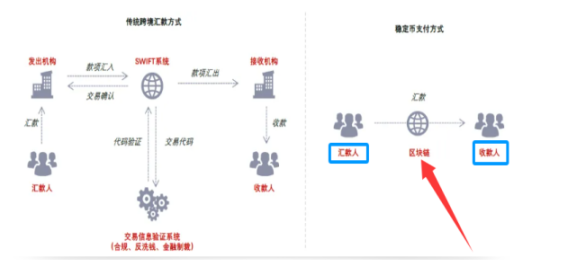
In the early stage of implementing KYC\AML for remitters and payees, the essence of blockchain technology will play a real role in the era of stablecoins. At the same time, blockchain (public chain, private chain, alliance chain) becomes a key infrastructure, and the speed of construction must be synchronized with the implementation and actual adoption of the stablecoin bill.


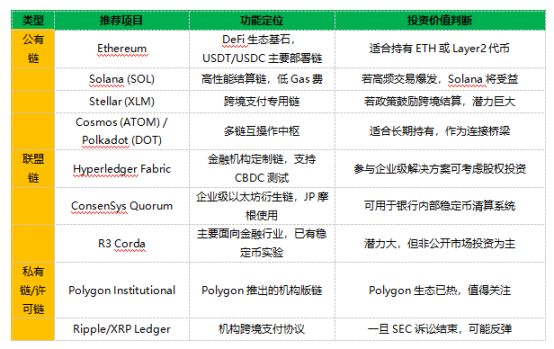
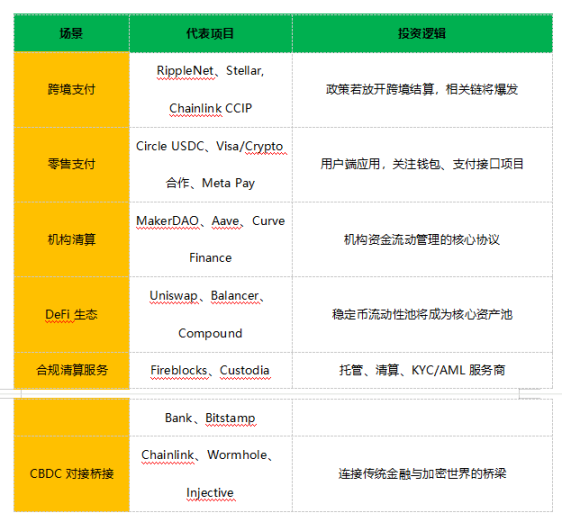
Ø Base and Polygon are the most likely to become standard compliant settlement layers under US regulations, and Ethereum will continue to be the most high-end audited stablecoin platform (such as USDC).
Ø Quorum and Hyperledger Fabric are most likely to become the "interbank back-end system" for global financial compliance stablecoins, used for cross-border clearing and value settlement.
Ø Who will become the "infrastructure of the new financial Internet".
The following dimensions are considered:
Ø Compliance and licensing: Under the KYC/AML and Stablecoin Act framework, only projects that can meet regulatory requirements can be adopted on a large scale. This may mean projects that have good cooperation with traditional financial institutions or are tested in regulatory sandboxes.
Ø Technology maturity and scalability: Large-scale transactions of stablecoins require a high-performance, low-latency, and high-throughput blockchain network.
Ø Security and stability: As a financial infrastructure, security is of paramount importance.
Ø Interoperability: Interoperability between different stablecoins and different blockchains will be the key to improving efficiency and reducing costs.
Ø Ecosystem and Adoption: Having an active developer community, abundant DApps, and cooperation or adoption by existing financial institutions are important indicators.
Ø Governance model: Blockchains that can adapt to future regulatory changes and provide stable and reliable governance have greater advantages.
Under strong regulation, a public chain that can truly become a stablecoin infrastructure often needs to have a high degree of transparency and decentralization, while at the same time being compatible with regulatory requirements.
In the context of the "stable currency bill being implemented and actually adopted", the projects that will be given priority to obtain the dividends of the era will be those:
1. Projects that can directly meet the compliance needs of financial institutions and large enterprises.
2. Projects that can provide high-throughput, low-cost, secure and reliable transaction infrastructure.
3. Projects that can facilitate the seamless transfer of stablecoins between different chains.
Are Defi and RWA the first wave of dividends?
Ø After the stablecoin is launched, RWA will become the second compliant asset class recognized by regulators and will be deeply integrated with the real asset financial system, bringing huge opportunities for asset chain + transaction globalization + custody transparency.
Ø It should be noted that the stablecoin regulatory rules that "interest is not allowed to be paid to stablecoin holders" means that stablecoin issuers cannot complete the basic commercial banking operations of "deposit-loan" and need to rely on other means to cover operating costs and innovate other business models to achieve profitability, which relies on the innovative use of stablecoins in the entire financial system;
As of the end of May 2025, the market value of mainstream stablecoins totaled approximately US$230 billion, an increase of more than 40 times compared to the size at the beginning of 2020. The growth rate is relatively fast, but it is still relatively small compared to the mainstream financial system, equivalent to only 1% of onshore deposits in the United States. However, in terms of transaction volume, stablecoins play an obvious role as an important means of payment and infrastructure in the cryptocurrency system. The annual transaction volume of mainstream stablecoins (USDT and USDC) reached US$28 trillion, exceeding the annual transaction volume of credit card organizations Visa and Mastercard. With the inclusion of stablecoins in the financial regulatory framework, decentralized finance is also expected to usher in development opportunities and deepen its integration with the traditional financial system.
Stablecoins are a "bridge" between the traditional financial system and the decentralized financial system (Defi).
According to the World Bank, as of the third quarter of 2024, the average global remittance rate is 6.62%. The United Nations 2030 Sustainable Development Goals require that this fee be reduced to no more than 3%, and the arrival time will take 1-5 working days. The efficiency of the traditional financial system is mainly affected by the need to pass through the SWIFT network of multiple transit banks. In contrast, the transaction cost of using stablecoin remittance rates is generally less than 1%, and the time is generally within a few minutes. However, it is worth noting that stablecoin payments have not been included in KYC and anti-money laundering supervision before the bill was introduced, which also poses a challenge to cross-border capital account controls in emerging markets. Therefore, although the use of stablecoins for cross-border payments is technically more efficient, in fact, this difference comes to a certain extent from regulatory differences, and the compliance costs of stablecoins may also increase as regulation becomes standardized.
In theory, the 100% reserve asset requirement limits the ability of stablecoin issuers to expand credit. The process of exchanging deposits for stablecoins is actually the transfer of bank deposits rather than creation. Therefore, the issuance of stablecoins does not affect the US dollar money supply in theory, but when funds continue to flow out of deposits, it may cause banks to shrink their balance sheets and reduce money supply. The process of exchanging other currencies for US dollar stablecoins actually produces the effect of currency exchange, but this is reflected in the cross-border or cross-account flow of US dollars and does not affect the total US dollar money supply.
Lending platforms that use cryptocurrencies as collateral actually play a credit creation function similar to that of banks, which can increase the scale of "quasi-currency" (i.e. stablecoin) in the decentralized financial system, but do not affect the supply of traditional money. Since the application scenarios involved in the crypto asset financial system are mainly concentrated in the fields of payment and investment, and lending is mainly based on speculative demand, the scale of crypto asset lending platforms will be approximately US$37 billion by the end of 2024, which is relatively small.
The conversion of deposits into stablecoins may lead to deposit outflows. This effect is similar to the impact of money market funds and high-yield bond markets on the banking system. For example, since 2022, approximately US$2.3 trillion in deposits have flowed into money market funds in the high-interest rate environment in the United States, becoming one of the triggering factors of the Silicon Valley Bank risk event.
As of the first quarter of 2025, USDT and USDC issuers hold a total of approximately US$120 billion in U.S. Treasury reserves. If they are combined as an "economy", it will rank 19th among overseas economies holding U.S. Treasury bonds, between South Korea and Germany.
Stablecoins can mainly take on short-term US Treasury bonds within 3 months, and are expected to have limited absorption capacity for long-term US Treasury bonds. The interest rates of short-term US Treasury bonds are subject to the monetary policy control of the central bank and depend on real economic factors such as inflation and employment. For monetary policy, stablecoin issuers buy US Treasury bonds, which lowers short-term interest rates, requiring the central bank to withdraw currency for hedging; in the long run, the attraction of stablecoins to deposits may lead to a trend of financial disintermediation, and the migration of financing from the traditional financial system to the decentralized financial system, which may also weaken the effectiveness of the central bank's monetary policy control.
Key considerations and challenges
Ø Legal and regulatory framework: This is the core of RWA development. Different countries and regions have huge differences in the definition and regulation of "security tokens", "digital assets" and "stablecoins". Compliance is the key to the success of the project.
Ø Asset valuation and custody: The valuation of off-chain assets, transfer of legal ownership, custody and audit of physical assets are an integral and complex part of the RWA tokenization process.
Ø Off-chain and on-chain links: How to safely and reliably map the information and legal status of off-chain assets to on-chain tokens requires reliable oracle and legal agreement support.
Ø Liquidity and market depth: Even with tokenization, if the market lacks enough buyers and sellers, liquidity may still be insufficient. The popularity of compliant stablecoins is expected to alleviate this problem.
Ø Interoperability: Different RWA tokens may be issued on different blockchains. Cross-chain technology will play an important role in achieving seamless transactions and circulation between them.
The projects that will be given priority to receive the dividends of the era will be those:
Ø Institutions with strong traditional financial backgrounds and licenses, or blockchain technology companies that have deep cooperation with such institutions. (Such as Franklin Templeton, BlackRock, JPMorgan Chase's Onyx, and Securitize that provides services)
Ø Projects that can effectively solve complex issues such as legal compliance, asset custody, valuation, and off-chain and on-chain mapping.
Ø Choose projects that are deployed on a blockchain (whether it is a public chain's Layer 2 or a consortium chain) that is regulation-friendly and has high performance and high liquidity potential.
RWA Ecological Panorama (by Function)
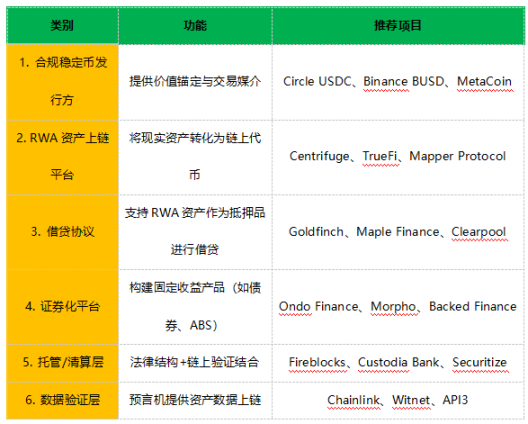
1. Tokenization of real estate/trust assets (easiest to implement)
Real estate is one of the RWA categories that is most receptive to stablecoins as “on-chain dollars”, with stable returns and liquidability. Many traditional real estate investment trusts (REITs) or private real estate funds may choose to tokenize their shares. This will not only lower the investment threshold and attract small investors, but also increase the liquidity of the secondary market. Regulators in Hong Kong, Dubai and other places are also actively promoting real estate tokenization projects.
2. Financial paper RWAs such as government bonds and corporate bonds (high growth potential)
Stablecoins are the natural counterpart of "dollar support + income distribution"; Treasury bonds + stablecoins are the most popular combination among regulators. The tokenization of this type of asset is currently the fastest growing and largest in the RWA field. Compliant stablecoins (such as USDC, and even future bank-issued stablecoins) are directly used as settlement currencies for these tokenized securities.
3. Gold/Commodity RWA (Natural Anchor for Stablecoins)
Gold can naturally be tokenized, and stablecoins themselves use gold as a reserve option; the on-chain gold standard can assist in the allocation of safe-haven assets.
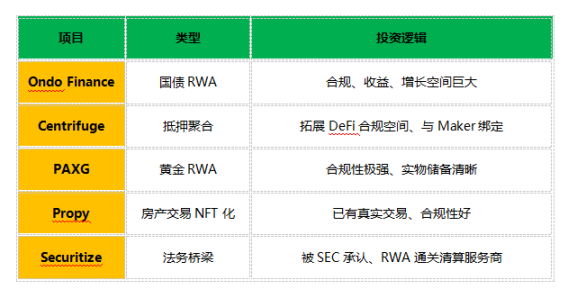
Ondo Finance (for example only, not investment advice, nor does it express an opinion on token prices)
It is an RWA tokenization platform that focuses on the tokenization of fixed-income assets (such as US Treasuries, ETFs, and real estate trusts) to provide high-yield opportunities for institutional and retail investors.
Technical features:
Ø Based on Ethereum Layer 1 and Layer 2 (such as Optimism), the transaction cost is low and the speed is fast.
Ø Provide structured financial products (such as senior/secondary tokens) to meet different risk preferences.
Ø Integrate Chainlink oracles to ensure asset price transparency.
Ø Cooperate with brokers registered with the SEC to ensure that tokenized assets comply with US regulations.
Ø Support KYC/AML and regular audits to meet the requirements of the GENIUS Act.
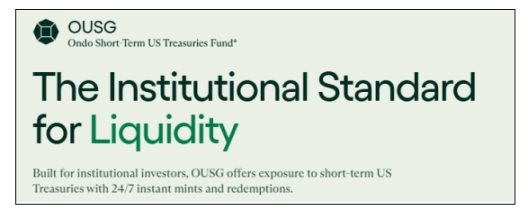
Issued to qualified investors (Qualified Purchasers), strict KYC/qualified investor certification is required.
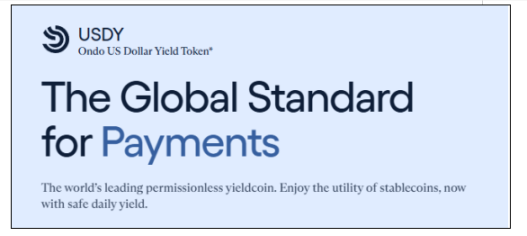
It is issued to non-US individuals and institutional users, and its returns are supported by short-term US Treasury bonds and bank deposit interest.
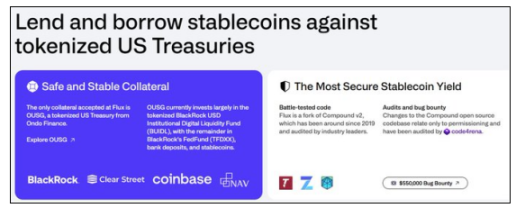
Flux Finance is a decentralized lending protocol developed based on the Compound V2 asset pool model. It supports users to use high-quality RWA assets (currently only OUSG is supported) as collateral to borrow stablecoins, and to lend idle stablecoins to earn interest.






